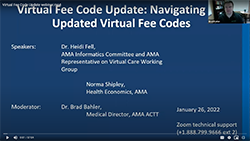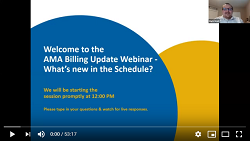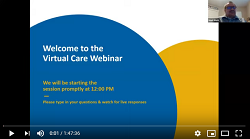Virtual Care
January 16, 2024

On this page
Webinars
AMA partners and stakeholders should feel free to use the presentation material as they see fit for their own members. The AMA would ask that, where applicable, partners recognize the AMA via a short credit/author note. Thank you!
Please visit Webinars & Online Learning for recordings of all past AMA webinars and details on upcoming webinars.
January 26, 2022
 Virtual Fee Code Update:
Virtual Fee Code Update:
Navigating the Updated Virtual Fee Codes
Hosted by AMA Health Economics and virtual care physician leaders, this webinar reviewed policy and progress to date in advancing changes to virtual health service codes, the latest changes in Virtual Care billing codes and practical applications of updated codes and modifiers. View slides.
April 3, 2020
Virtual Care codes and March 31 changes to the SOMB
 The AMA hosted a webinar focused on Virtual Care codes and the March 31, 2020 Schedule of Medical Benefits changes.
The AMA hosted a webinar focused on Virtual Care codes and the March 31, 2020 Schedule of Medical Benefits changes.
View presentation slides. The information herein is what was known on the date of the seminar. Any intervening changes in the SOMB are not reflected in the slide deck. For full information please ensure to check the AMA Fee Navigator® and direct any questions to Health Economics.
March 27, 2020
Getting started with Virtual Care and help with privacy, tools and billing
 The AMA hosted two webinars for Alberta physicians, focusing on how to start using Virtual Care for patient care while minimizing risk of exposure to patients, staff and physicians during the COVID-19 pandemic. Topics covered included getting started with Virtual Care, privacy, tools and billing. The two sessions were merged into one recording. View presentation slides
The AMA hosted two webinars for Alberta physicians, focusing on how to start using Virtual Care for patient care while minimizing risk of exposure to patients, staff and physicians during the COVID-19 pandemic. Topics covered included getting started with Virtual Care, privacy, tools and billing. The two sessions were merged into one recording. View presentation slides
Privacy
Any change in existing tools or introduction of new tools in your clinic requires a Privacy Impact Assessment.
For more information on getting started visit Privacy Impact Assessments on the OIPC website or Privacy Tools and Resources on the AMA website.
The Essentials to Getting Started with Virtual Care
- Obtain patient email addresses and/or mobile numbers
- Email addresses can be used for communicating new Virtual Care services to groups of patients, and depending on the Virtual Care tool can be used for sending the virtual visit link/URL to a patient.
- Mobile numbers are useful for communicating with a patient if there are any issues with the virtual visit, or to ensure they are ready for their visit.
- Inform patients
- Patients should be aware of what Virtual Care services are being provided and how they will be communicated (via clinic or provider email address, text message, invite via application, etc.).
- Confirm patient identity
- If a patient is previously known to the physician or staff, identity verification may be as simple as recognizing each other's voice.
- If not, ensure a process is in place to verify identity of the patient or their agent. This can be done by asking for full name, date of birth and one other key piece of information such as postal code.
- Obtain patient consent
- Verbal consent documented in the patient’s chart is fine as a minimum. CMPA recommends the use of a signed informed consent form: View Word version or PDF version
- CPSA has provided guidance on obtaining and documenting consent in the following COVID-19 Virtual Care Statement.
- Update patient chart
- Ensure all conversations electronic or otherwise are documented in the patient chart. Do not rely upon the Virtual Care tool to document patient care episodes.
- View checklist version of the above content
Virtual Care Tools
The CPSA COVID-19 Virtual Care Statement states that “The CPSA recognizes that in the extraordinary circumstances posed by the pandemic where patient safety may be compromised by a delay in deployment of Virtual Care technologies, that short term use of unregulated Virtual Care technology can be justified.”
To support the CPSA message the AMA is providing members with key information below on both regulated (PIA accepted by OIPC) and unregulated options. It’s important to note that many unregulated options may meet privacy and security requirements. This will be determined once a PIA is completed and submitted by a custodian in Alberta.
EMR Integrated Tools
The following tools offer integration with community EMRs.
- Brightsquid Secure-mail is integrated into Alberta MyHealth Records and TELUS Health MedDialog. Use it for secure communication with patients, physicians, and allied health professionals. Secure-Mail is free for the first two months.
- Microquest offers a full suite of Virtual Care tools, including a Patient Portal with secure Patient Messaging, Virtual Appointments and Intake Forms that can be completed on any device, all fully integrated within Healthquest. In addition, dr2dr Secure Messaging continues to be free of charge to all health care professionals across Canada. Visit Microquest.ca for more information.
- QHR (Accuro EMR) offers Accuro Engage as part of an integrated suite of products for Accuro users to connect with their patients and Medeo Virtual Care for non-Accuro users. Both products provide secure and easy communication. Please contact QHR to sign up or if you would like more information.
- TELUS Health has details and regular updates on TELUS Health Virtual Care offerings - many offered for free during the pandemic, related tip sheets, COVID-19 related templates, and critical contact information. They have also created province specific guidance on their EMR product capabilities in Get More From Your EMR.
View additional details on EMR integrated solutions
AHS Tools
- Zoom.us is currently in use by AHS in various locations.
Unintegrated Tools
There are many other virtual care tools available to Alberta physicians. While they are not integrated with community EMRs, many do meet privacy and security requirements and may work with your clinic workflow.
We have consolidated a list in our toolkit of various offerings with some functional, and privacy and security compliance details. This list will be updated as new information becomes available. We do not have a formal accreditation or validation process, so we highly recommend that physicians perform a thorough review of the solution prior to selection.
We recommend the use of regulated tools. However, for use in urgent situations, unregulated tools can be considered when “safer” options may not be available. They may not necessarily meet privacy and security requirements such as data stored within Canada, encryption, etc.
Billing Codes
Please refer to AMA Fee Navigator® and AMA Billing Corner for detailed information on available virtual care billing codes.
Toolkit and Workflow Algorithm
A deeper dive on implementing Virtual Care in your practice: Download the toolkit.
Visit Meeting Patients’ Needs: Algorithm for Today’s Primary and Specialty Care Teams for a stepwise approach to conducting patient care management and access to all tools associated with this algorithm.
The AMA thanks the Doctors of BC for providing valuable material that we continue to leverage to support our members.
Additional Resources
- Canada Health Infoway: Clinical Change Virtual Care Toolkit
- CPSA Standard of Practice: Vitual Care
- CPSA Advice to the Profession: Virtual Care
- CPSA Advice to Albertans: Virtual Care
- CMPA - Providing Virtual Care during the COVID-19 Pandemic
- AMA COVID-19 physician resource center webpage
- Using Broadcast Communications to keep patients informed
- CMA Virtual Care Playbook
- AHS Virtual Health
- Connect Care Bytes Blog from AHS CMIO Office
- Connect Care Manual for Virtual Care
- OntarioMD Virtual Care Resources
- Doctors of BC Virtual Care Resources
Updates to this webpage will be made as new information becomes available.
If you have any questions please contact caroline.garland@albertadoctors.org
Virtual Care News
Considering a telemedicine or virtual care business in Canada? What you need to know
January 16, 2024
Are you thinking about launching a virtual care or telemedicine business in Canada this year? This bulletin provides an overview of recent regulatory requirements for physicians to consider.
Enhanced virtual care code bulletin now posted
January 12, 2022
PRESIDENT'S LETTER: The Alberta Health Bulletin for enhanced virtual care codes has now been published.
Update - Alberta Health bulletin on virtual care code changes
January 7, 2022
PRESIDENT'S LETTER: I have heard from many physicians since the announcement of changes to virtual code priority items (time for indirect care and complex modifiers). Like me, they were happy to hear the news that these codes will be available, but urgently needing the details in an accompanying Alberta Health Bulletin.
Priority virtual care codes to increase
December 30, 2021
PRESIDENT'S LETTER: I am pleased to tell you about some changes to virtual care fee codes that are coming into effect January 1, 2022. They will be announced today in a joint news release from government and the Alberta Medical Association. As I’ve mentioned in past letters, a working group involving Alberta Health, Alberta Health Services, the College of Physicians & Surgeons of Alberta and the AMA has been looking at both short- and long-term considerations around virtual care. Among other issues, the AMA has been advocating for changes to the virtual care fee schedule to make the provision of virtual care more financially sustainable.
